Top>HAKUMON Chuo [2017 winter Issue]>A New Rakugo Star from Sweden “My name is San’yūtei Jūbei”
 Index
Index
Visiting an Alumnus
A New Rakugo Star from Sweden “My name is San’yūtei Jūbei”
Johan Nilsson Björk, a 32-year-old Swede, came to study at the Chuo University Faculty of Letters as an exchange student. He is now a rakugoka (a professional rakugo comic storyteller) by the name of San’yūtei Jūbei, training at the zenza level. He is in the spotlight as one of the newcomers of the Japanese traditional arts of storytelling.
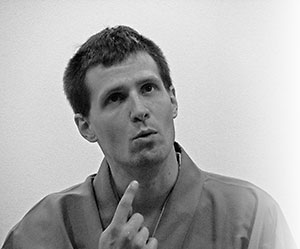
He asked the rakugo master, San’yūtei Kōraku – a long-standing member of Shōten on the Nippon TV network – to become his disciple, having felt a real warmth in his style of storytelling. He became a disciple on July 15, 2016.
Training as zenza
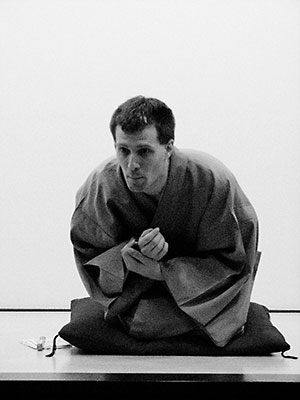
During a rakugo performance in the shitamachi (traditional commercial and entertainment areas) of Tokyo, a tall man of 185 cm in stature appears on stage. The audience is being stunned by the different mood from normal. Having folded his long legs beneath him, Jūbei duly opened his mouth: “As you can see, I’m not from Japan. I came all the way from Sweden and somehow ended up a rakugoka. Please rest assured by the way: there will be loads of Japanese rakugoka coming on stage after me.”
After making the audience feel relaxed, he performs his brilliant rakugo. His number today is Momotaro.
Why does the grandpa have to go to the mountain, and why does the grandma go to the river? The father lectures and the son listens; suddenly the son becomes skeptical of the plot and starts giving his own commentary interpreting the author’s intentions. This funny exchange is the core of this number. Jūbei tells the story of Momotaro’s companions to the Onigashima Island – a dog, a monkey and a pheasant – using all he has to offer too.
With his dexterous speech techniques, he keeps on playing out different characters in front of the mesmerized audience. With the final punch line, the recital is over and the audience erupts in rapturous applause.
There is a hierarchy in the world of rakugoka. Starting with zenza trainee, everyone gradually rises through the ranks via zenza, futatsume until one becomes shin’uchi. From futatsume, you are allowed to put on a haori-coat and also can call yourself a rakugoka (rakugo from the Kansai region has a different system).
A day for a zenza is all about training: looking after his superiors backstage; making tea – some prefer it hot, while the others prefer it strong. You need to know all their different tastes; helping them getting changed into stage gears; folding their kimono and there are many rules you have to learn about folding kimono, too.
Turning over a zabuton (Japanese cushion) on stage is called kōza-gaeshi (literally stage turning). It is a well-known sight in rakugo, and it is done after a performance to change the scene. And there are conventions to follow here, too: spreading four tufts on the corner; and you are not to put the seam towards the audience – this is to show that you are inviting the audience members for their uninterrupted patronage.
Even on a hot summer day, you have to wear a long-sleeved top outside. There are rakugo stories in which you have to show your bare arms depicting putting up with the pain of burning moxa (a kind of dried herb used in Eastern medicine) on your arm: if you are too tanned, it literally doesn’t make the story.
In rakugo, often there are scenes in which the characters hold a rice bowl. Even such seemingly quotidian movements can be a bit perplexing, according to Jūbei, as most Westerners wouldn’t pick up the crockery during meal as being bad manners. One has to learn different customs.
For a foreigner, it is certainly not easy to learn and master these myriad things that are not immediately obvious even for today’s Japanese youngsters.
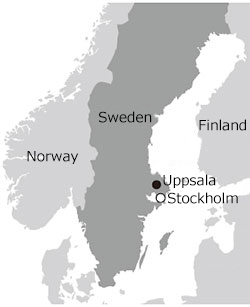
Johan Nilsson was born on October 3, 1985 in Uppsala, the fourth largest city in Sweden, about a 40-minute drive up north from the capital Stockholm. As a child, he was a big fan of Japanese anime and manga such as Dragon Ball and Naruto. This led him to become interested in Japan and learn some Japanese.
At high school he found a Japanese language class. This reignited his passion for the Japanese language and he eventually majored in Japanese at Stockholm University.
After intense studying, he was selected as an internal exchange student and came to study at Nanzan University in Nagoya City for a short period. After a temporary return to Sweden, he came back in his fourth year to the Chuo University Faculty of Letters in Tokyo, where he had really wanted to visit one day, for the period of a year. It was the spring of his 26th year.
“In the freshers’ events I was allured into rakugo and rakugo study group not knowing what to expect, but once there I really liked their short comedy sketches and manzai.”
He already had a nearly full command of Japanese but hadn’t heard of rakugo. “You wouldn’t find it in Sweden,” he tells cheekily. He joined the rakugo study group. At first he found seiza (sitting on one’s legs folded underneath) excruciating. He was also interested in straight plays, so also joined the 2nd drama study group. By nature he likes entertaining and pleasing people.
During his time at Chuo University, Johan performed during the Hakumon Sai (Chuo University’s annual festival). His height was a bit of a problem as the stage kimono owned by the club was barely big enough for him but his enthusiastic performance won the audience over, and helped grow the fan base of Chuo University’s rakugo study group greatly.
Rakugo for graduation thesis
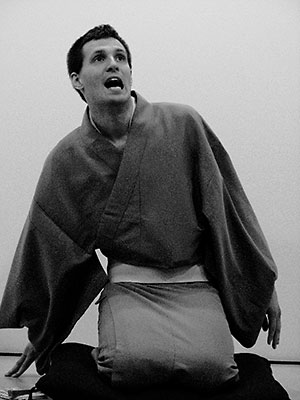
After the period of study in Tokyo, he returned to Sweden and graduated from Stockholm University: his graduation thesis was on rakugo.
In the spring of his 29th year, Johan returned to Japan. While studying at a specialist drama school in Tokyo for 3 years, he would frequent yose (rakugo halls) and absorbed the pleasure of rakugo. Gradually he became anxious to go on the rakugo stages himself. The reason he fell in love with rakugo of San’yūtei Kōraku was because he felt “his way of storytelling had a real warmth to it.”
After one variety performance at Ryogoku Yose in Tokyo, where Kōraku and other masters make a regular appearance, Johan made up his mind and directly appealed to Kōraku to be accepted as one of his disciples. He poured his passion and also had a letter written in Japanese with him.
According to Jūbei, his parents back in Sweden are apparently saying, “Do whatever you like.” He also added, “I think they don’t know what rakugo is, but they hope things will work out somehow.”
“In rakugo, one performer becomes everyone from old to young, and male to female, merely holding a fan and a tenugui (a kind of hand towel). Every emotion including happiness and sorrow is expressed by you alone. It is a wondrous world and I find it really fascinating.”
One day he may even perform rakugo outside Japan. He thinks it is his role to let the wider world know of rakugo, too.
Words from San’yūtei Kōraku
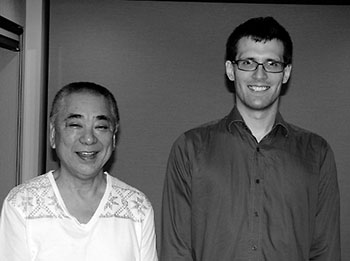
There was this foreigner laughing in the middle of the auditorium at Ryogoku Yose. After finishing the final number that day, my disciple came and told me, “A foreign gentleman says he wants to talk to you.”
This was the man I noticed in the audience while speaking. And he said, “Please make me your disciple.”
I told him that I couldn’t have a proper chat with him right there and asked him for his contact details. And at that moment a letter appeared in front of me. I read it with my wife when I got home.
It was addressed to me in both kanji and kana. On the back it said Johan Nilsson. The body of letter also incorporated kanji properly: “Please accept my apologies...” He went on with more kanji “for writing to you suddenly in this manner.” “I heard many of your rakugo performances, and your performances have a real warmth. Please make me your disciple.” The letter was written on three leaves.
After a while we met up and it went like this: “Are you sure, you are ok with coming here?” “Yes, please let me train here.” “Ok, in that case let’s start from scratch.”
No point hurrying
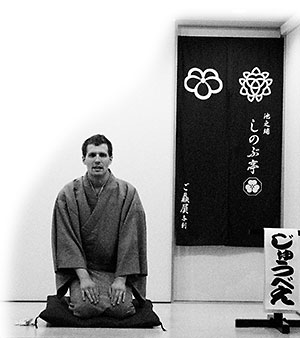
Before learning rakugo, there are many things one has to learn like greetings, seiza, use of words, conventions, and so on. In learning these things, you gradually start to understand, though you won’t get it at first.
Like in rakugo, the way you say “Ippai nomasete chodai. (Please can you let me have a drink?)” and “Ippai nomasete. (Can you let me have a lot of drink?)” would have different implications. Also the words like hashi (chopsticks) and hashi (bridge). It’s hard but his elder disciples will give him advice and I will also tell him. It’s all learning through practice: he’s at that stage at the moment.
I don’t believe for a minute that he would have mastered what I taught him today by tomorrow. It’s like the “Hare and Tortoise” story.
Performers who can’t make the audience laugh will doubt themselves. Looking at other rakugoka, they think “he (she) speaks so well. I wonder what I’m doing wrong.”
They keep doubting themselves. And precisely this doubting is what’s really important. The more you doubt, the more you will know later.
Accumulate without rushing and remember, accumulate and remember, accumulate and remember... The world of rakugo is about this repetition, and it’s been like this ever since the Edo period.
Someone who memorizes a number quickly and is received well by audiences can easily become conceited. They think they’re talented, and looking behind them, they think “I can’t believe you’re still back there. I can’t wait for you anymore” and the hare thinks the world is his (her) oyster.
The tortoise is drenched in sweat day after day, agonizing about how he (she) should do this number this way, or maybe that way is better... Eventually the tortoise will be far beyond the hare.
Whatever you do, don’t rush things. Don’t run. And don’t try to make yourself look bigger than you are. Don’t be suddenly good at what you do either.
It takes time to master a story. It becomes part of you and you make it really your own: this is your real treasure. We have all been doing it this way, not just a Swede!
5 years, 10 years, 20 years... If he is a master after about 30 years, I’d be really happy.
Tenth disciple

I keep saying, “It’s not just about becoming good at performing rakugo. Learn about things that are more important.” It is compassion and kindness to others.
In rakugo, our job is to make audiences happy. So it is really not on if a rakugoka deceived, lied, boasted to people and so on. Make yourself a better person. If you are not good at it, then you make sure to improve even more.
If someone is in trouble, help that person. If there is an elder disciple, you tell him “let’s go eat together,” and if there is your junior, you would say, “Hey, let’s go have a drink.” I really would love him to become a person who can do things like that any time. That is my wish.
I believe in destiny about everything in the world. It was our destiny that he came to me.
Jūbei is my tenth disciple. When giving him a name I thought, “He’s number 10 (jū in Japanese), so maybe Jūbei?” We often give katakana name to our foreign disciples, though.
He said “It sounds cool, like a samurai. Thank you very much!” and we decided to go with hiragana so it is more likeable for everyone.
I present you San’yūtei Jūbei – we appreciate your continued support.
- Pofile
- Rakugo master San’yūtei Kōraku
He was born in Tokyo in 1946. He became a rakugo disciple in 1966 at the age of 19 and rose through the ranks to reach futatsume in 1971 and shin’uchi in 1982. He has been a regular member of Shōten on the Nippon TV network for 34 years since 1983. He also runs a unique variety hall Ikenohata Shinobutei in Taito City, Tokyo for nurturing young talents.
Japanese Language Education in Sweden
According to the Ministry of Foreign Affairs website and the Japan National Tourism Organization, an interest in Japanese culture is generally high in Sweden. In recent years, spotlights have been shone on Japan’s pop culture such as anime and manga, and its cuisine. Also more Swedish people are visiting Japan as tourists (about 50,000 in 2016).
Japanese language education in Sweden started when a course was set up at Uppsala University in 1956, and Stockholm University, University of Gothenburg and Lund University followed suit in 1963, 1974 and 1980 respectively.
- Research Activities as a Member of Research Fellowship for Young Scientists (DC1), Japan Society for the Promotion of Science (JSPS) Shuma Tsurumi
- Important Factors for Innovation in Payment Services Nobuhiko Sugiura
- Beyond the Concepts of Fellow Citizens and Foreigners— To Achieve SDGs Goal 10 “Reduce Inequality Within and Among Countries” Rika Lee
- Diary of Struggles in Cambodia Fumie Fukuoka
- How Can We Measure Learning Ability?
—Analysis of a Competency Self-Assessment Questionnaire— Yu Saito / Yoko Neha - The Making of the Movie Kirakira Megane








